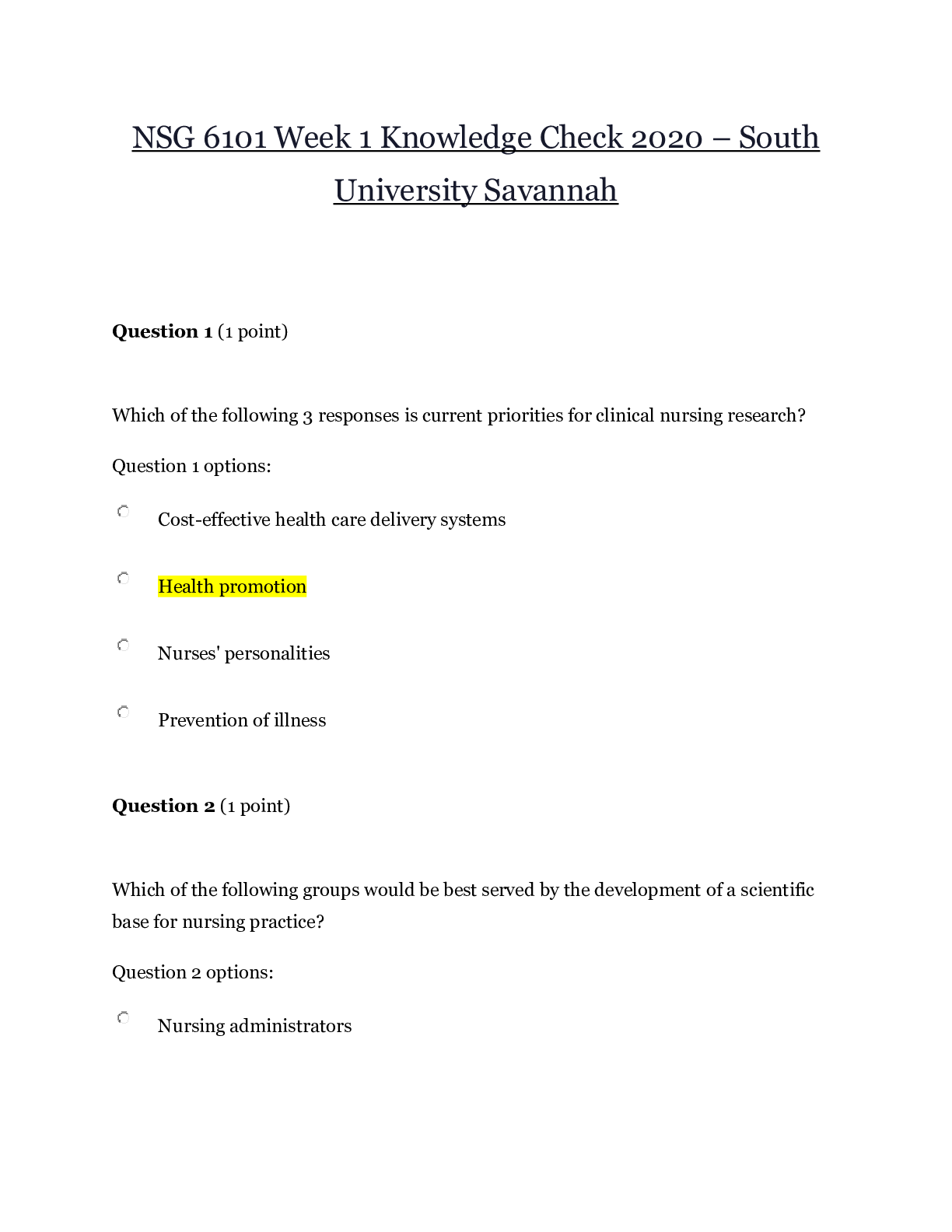*NURSING > EXAM > NSG 6420 Week 10 Final Exam 2020 South University Savannah | NSG6420 Week 10 Final Exam 2020 (All)
NSG 6420 Week 10 Final Exam 2020 South University Savannah | NSG6420 Week 10 Final Exam 2020
Document Content and Description Below
NSG 6420 Week 10 Final Exam 2020 South University Savannah 1. In AR disorders, carriers have: • Two mutated genes; two from one parent that cause disease • A mutation on a sex chromosome tha... t causes a disease • A single gene mutation that causes the disease • One copy of a gene mutation but not the disease 2. A 76-year-old patient with a 200-pack year smoking history presents with complaints of chronic cough, dyspnea, fatigue, hemoptysis, and weight loss over the past 2 months. The physical exam reveals decreased breath sounds and dullness to percussion over the left lower lung field. The chest X-ray demonstrates shift of the mediastinum and trachea to the left. These are classic signs of: Lung cancer Tuberculosis Pneumonia COPD 3. The nurse practitioner is discussing lifestyle changes with a patient diagnosed with gastroesophageal reflux. What are the nonpharmacological management interventions that should be included? It will be helpful to keep the head of your bed elevated on blocks 4. In examining the mouth of an older adult with a history of smoking, the nurse practitioner finds a suspicious oral lesion. The patient has been referred for a biopsy to be sent for pathology. Which is the most common oral precancerous lesion? leukoplakia 5. You have a patient complaining of vertigo and want to know what could be the cause. Knowing there are many causes for vertigo, you question the length of time the sensation lasts. She tells you several hours to days and is accompanied by tinnitus and hearing loss. You suspect which of the following conditions? Ménière’s disease Benign paroxysmal positional vertigo Transient ischemic attack (TIA) MigraineDefinition 6. Age-related changes in the bladder, urethra, and ureters include all of the following in older women except: A. Increased estrogen production’s influence on the bladder and ureter B. Decline in bladder outlet function C. Decline in ureteral resistance pressure D. Laxity of the pelvic muscle 7. Your patient has been using chewing tobacco for 10 years. On physical examination, you observe a white ulceration surrounded by erythematous base on the side of his tongue. The clinician should recognize that very often this is Malignant melanoma Squamous cell carcinoma Aphthous ulceration Behcet’s syndromeDefinition 8. When interpreting laboratory data, you would expect to see the following in a patient with Anemia of Chronic Disease (ACD) Hemoglobin <12 g/dl, MCV decreased, MCH decreased Hemoglobin >12 g/dl, MCV increased, MCH increased Hemoglobin <12 g/dl, MCV normal, MCH normal Hemoglobin >12 g/dl, MCV decreased, MCH increased 9. What test is used to confirm the diagnosis of appendicitis? CBC Flat plate of abdomen Rectal exam CT of abdomen with attention to appendix 10. Functional abilities are best assessed by: observed assessment of function 11. Your patient is a 43-year-old female golfer who complains of arm pain. On physical examination, there is point tenderness on the elbow and pain when the patient is asked to flex the wrist against the clinician’s resistance. These are typical signs of: Carpal tunnel syndrome Osteoarthritis of the wrist Epicondylitis Cervical osteoarthritis 12. An 86-year-old patient who wears a hearing aid complains of poor hearing in the affected ear. In addition to possible hearing aid malfunction, this condition is often due to Acoustic neurom Cerumen impaction Otitis media Ménière’s disease 13. Which lesions are typically located along the distribution of dermatome? Herpes Zoster 14. n differentiating a gastric ulcer from a duodenal ulcer, you know that each type of ulcer can present with distinct signs and symptoms. Which of the following pieces of information from the patient’s history is the least useful for you to determine that the patient has a duodenal ulcer? A. Pain occurs on an empty stomach B. Diffuse epigastric pain C. Rarely associated with non-steroidal use D. Occurs in patients under 40 years of age 15. A pneumatic otoscopic examination is used to assess: A. Inner ear conditions B. Otitis externa C. Cerumen impaction D. Tympanic membrane mobility 16. In autosomal recessive (AR) disorders, individuals need: • Only one mutated gene on the sex chromosomes to acquire the disease • Only one mutated gene to acquire the disease • Two mutated genes to acquire the disease • Two mutated genes to become carriers 17. Which of the following disorders can cause urinary incontinence? Cystocele Overactive bladder Uterine prolapse All of the above 18. An older patient reports burning pain after ingestion of many foods and large meals. What assessment would assist the nurse practitioner in making a diagnosis of GERD? A. Identification of a fluid wave B. Positive Murphy’s sign C. Palpable spleen D. Midepigastric pain that is not reproducible with palpation 19. Which of the following medications are commonly associated with the side effect of cough Beta blocker B. Diuretic C. ACE inhibitor D. Calcium antagonist 20. A 55-year-old post-menopausal woman with a history of hypertension complains of jaw pain on heavy exertion. There were no complaints of chest pain. Her ECG indicates normal sinus rhythm without ST segment abnormalities. Your plan may include Echocardiogram B. Exercise stress test C. Cardiac catheterization D. Myocardial perfusion imaging 21. Your 24-year-old female patient complains of dysuria as well as frequency and urgency of urination that develops the day after she uses her diaphragm. Urine culture reveals a bacterial count of 100 CFU/mL. These signs and symptoms indicate . Upper urinary tract infection B. Lower urinary tract infection C. Normal bacteriuria D. Urethritis 22. Epistaxis can be a symptom of: 23. A careful history of a female client with a chief complaint of intermittent diarrhea reveals that she also experiences bouts of constipation. She has no known allergies and experienced no unintentional weight loss. What is the most likely condition Inflammatory bowel disease Irritable bowel syndrome Giardiasis Lactose intolerance 24. When assessing an elderly client who reports a tremor, which assessment findings would be most reliable in identifying Parkinson’s disease? Any presence of tremor Symptoms of slowed movement, unstable angina, and tremor Resting tremor, slow unsteady gait, and cogwheel resistance Cogwheel rigidity, bradykinesia, and amnesia 25. Which of the following best describes the pain associated with osteoarthritis? A. Constant, burning, and throbbing with an acute onset? B. Dull and primarily affected by exposure to cold and barometric pressure C. Begins upon arising and after prolonged weight bearing and/or use of the joint D. Begins in the morning but decreases with activity 26. During physical examination of a patient, you note resonance on percussion in the upper lung fields. This is consistent with: A. COPD B. Pneumothorax C. A normal finding D. Pleural effusion 27. Jeff, 48 years old, presents to the clinic complaining of fleeting chest pain, fatigue, palpitations, lightheadedness, and shortness of breath. The pain comes and goes and is not associated with activity or exertion. Food does not exacerbate or relieve the pain. The pain is usually located under the left nipple. Jeff is concerned because his father has cardiac disease and underwent a CABG at age 65. The ANP examines Jeff and hears a mid-systolic click at the 4th ICS mid-clavicular area. The ANP knows that this is a hallmark sign of: Angina Pericarditis Mitral valve prolapse Congestive heart failur 28. During auscultation of the chest, your exam reveals a loud grating sound at the lower anterolateral lung fields, at full inspiration and early expiration. This finding is consistent with: Pneumonia Pleuritis Pneumothorax CORRECT A and B 29. Your patient complains of a feeling of heaviness in the lower legs daily. You note varicosities, edema, and dusky color of both ankles and feet. Which of the following is the most likely cause for these symptoms? Femoral vein thrombosis Femoral artery thrombus CORRECT Venous insufficiency Musculoskeletal injury 30. Which of the following details are NOT considered while staging asthma? A. Nighttime awakenings B. Long-acting beta agonist usage C. Frequency of symptoms D. Spirometry findings 31. Mr. A presents to your office complaining of chest pain, mid-sternal and radiating to his back. He was mowing his lawn. He reports the pain lasting for about 8 minutes and went away after sitting down. What is his most likely diagnosis based on his presenting symptoms Acute MI GERD Pneumonia Angina 32. A 22-year-old female patient complains of excessive thirst, feeling “shaky when she misses meals” and increased frequency of urination. Family history is positive for cardiovascular disease, cerebrovascular disease, and diabetes. The patient denies use of tobacco, alcohol, or other drugs. She takes no medication. Daily diet is fast food, and the patient does not exercise regularly. On physical examination, there are no significant findings except obesity, demonstrated by a BMI of 35 and blood pressure of 145/ 90. The signs and symptoms are characteristic of: Type 2 diabetes mellitus B. Chronic fatigue syndrome C. Cushing’s disease D. Clinical depression 33. Your 66-year-old male patient has recently started treatment for metabolic syndrome and is currently taking the following medications: an ACE inhibitor and beta blocker for treatment of hypertension. He is also taking a statin medication, simvastatin for hyperlipidemia, and a biguanide, metformin, for type 2 diabetes. The patient complains of myalgias of the legs bilaterally and blood work shows elevated serum creatine kinase. Which of the medications can cause such a side effect? A. Beta blocker B. ACE inhibitor C. Statin medication D. Metformin 34. . Helicobacter pylori is implicated as a causative agent in the development of duodenal or gastric ulcers. What teaching should the nurse practitioner plan for a patient who has a positive Helicobacter pylori test? A. It is highly contagious and a mask should be worn at home. B. Treatment regimen is multiple lifetime medications. C. Treatment regimen is multiple medications taken daily for a few weeks. D. Treatment regimen is complicated and is not indicated unless the patient is symptomatic. 35. Which of the following is the most important question to ask during cardiovascular health history? Sudden death of a family member 36. Dan G., a 65-year-old man, presents to your primary care office for the evaluation of chest pain and left-sided shoulder pain. Pain begins after strenuous activity, including walking. Pain is characterized as dull, aching; 8/10 during activity, otherwise 0/10. Began a few months ago, intermittent, aggravated by exercise, and relieved by rest. Has occasional nausea. Pain is retrosternal, radiating to left shoulder, definitely affects quality of life by limiting activity. Pain is worse today; did not go away after he stopped walking. BP 120/80. Pulse 72 and regular. Normal heart sounds, S1 and S2, no murmurs. Which of the following differential diagnoses would be most likely Musculoskeletal chest wall syndrome with radiation Esophageal motor disorder with radiation Acute cholecystitis with cholelithiasis Coronary artery disease with angina pectoris 37. The most common neurological cause of seizures in an older adult is Alzheimer’s disease Multiple sclerosis Stroke Peripheral neuropathy 38. A 70-year-old white male comes to the clinic with a slightly raised, scaly, pink, and irregular lesion on his scalp. He is a farmer and works outside all day. You suspect actinic keratosis, but cannot rule out other lesions. What recommendation would you give him? A. Ignore the lesion, as it is associated with aging. B.Instruct him to use a nonprescription hydrocortisone cream to dry up the lesion. C.Perform a biopsy or refer to a dermatologist. D.Advise him to use a dandruff shampoo and return in one month if the lesion has not gone away. 39. A 59-year-old patient with history of alcohol abuse comes to your office because of ‘throwing up blood”. On physical examination, you note ascites and caput medusa. A likely cause for the hematemesis is: Peptic ulcer disease Barrett’s esophagus Esophageal varices Pancreatitis 40. A 66-year-old patient presents to the clinic complaining of dyspnea and wheezing. The patient reports a smoking history of 2 packs of cigarettes per day since age 16. This would be recorded in the chart as: A. 50 x 2-pack years B. 100-pack years C. 50-year, 2-pack history D. 100 pack history 41. Which of the following conditions is the most common cause of nausea, vomiting, and diarrhea A. Viral gastroenteritis B. Staphylococcal food poisoning C. Acute hepatitis A D. E.coli gastroenteritis 42. The nurse practitioner orders bilateral wrist X-rays on a 69-year-old gentleman complaining of pain in both wrists for the past 6 weeks not related to any known trauma. The nurse practitioner suspects elderly onset rheumatoid arthritis. The initial radiographic finding in a patient with elderly onset rheumatoid arthritis would be: A. Symmetric joint space narrowing B. Soft tissue swelling C. Subluxations of the joints D. Joint erosion 43. Rheumatic heart disease is a complication that can arise from which type of infection? Epstein-Barr virus Diphtheria Group A beta hemolytic streptococcus Streptococcus pneumoniae 44. A 23-year-old patient who has had bronchiectasis since childhood is likely to have which ofthe following: Barrel-shaped chest Clubbing Pectus excavatum Prolonged capillary refill 45. Iron Deficiency Anemia (IDA) is classified as a microcytic, hypochromic anemia. This classification refers to which of the following laboratory data? A. Hemoglobin and hematocrit B. Mean Corpuscular Volume (MCV) and Mean Corpuscular Hemoglobin (MCH) C. Serum ferritin and serum iron D. Total iron binding capacity and transferrin saturation 46. An 82-year-old female presents to the emergency department with epigastric pain and weakness. She admits to having dark, tarry stools for the last few days. She reports a long history of pain due to osteoarthritis. She self-medicates daily with ibuprofen, naprosyn, and aspirin for joint pain. On physical examination, she has orthostatic hypotension and pallor. Fecal occult blood test is positive. A likely etiology of the patient’s problem is: A. Mallory-Weiss tear B. Esophageal varices C. Gastric ulcer D. Colon cancer 47. A 33-year-old female reports general malaise, fatigue, stiffness, and pain in multiple joints of the body. There is no history of systemic disease and no history of trauma. On physical examination, the patient has no swelling or decreased range of motion in any of the joints. She indicates specific points on the neck and shoulders that are particularly affected. She complains of tenderness upon palpation of the neck, both shoulders, hips, and medial regions of the knees. The clinician should include the following disorder in the list of potential diagnoses: A. Osteoarthritis B. Rheumatoid arthritis C. Fibromyalgia D. Polymyalgia rheumatica 48. Which of the following dermatological conditions results from reactivation of the dormant varicella virus? . A. Tinea versicolor B.Seborrheic keratosis C.Verruca D.Herpes zoster 49. A 68-year-old male reports painless rectal bleeding occasionally noted with thin pencil-like stools, but no pain with defection. He has a history of colon polyp removal 10 years ago but was lost to follow-up. The nurse practitioner’s appropriate intervention is: A. Digital rectal exam and send home with 3 hemoccult to return B. Immediate referral to gastroenterologist and colonoscopy C. Order a screening sigmoidoscopy D. Order a colonoscopy and barium enema and refer based on results 50. Which of the following drugs would be useful for the nurse practitioner to prescribe for an older adult to prevent gastric ulcers when a nonsteroidal anti-inflammatory drug is used for chronic pain management? Misoprostol (Cytotec) Cimetidine (Tagamet) Metronidazole (Flagyl) Bismuth subsalicylate (Pepto bismol) 51. A patient has a tender, firm, nodular cystic lesion on his scalp that produces cheesy discharge with foul odor. This is most likely a: A. Bacterial folliculitis B. Basal cell carcinoma C. Bullous impetigo D. Epidermoid cyst 52. The appearance of a 2-10 cm. herald patch with subsequent development of parallel oval lesions on the trunk in a christmas tree distribution involving the upper arms and upper legs are common in Pityriasis Rosea Shingles Psoriasis Lymes Disease 53. The most common complication of an untreated urinary obstruction due to a ureteral calculus is: Hydronephrosis B. Renal artery stenosis C. Ureteral rupture D. Kidney mass 54. Which of the following findings would indicate a need for another endoscopy in clients with peptic ulcer disease? Cases of dyspepsia with constipation B. Symptoms persisting after 6-8 weeks of therapy C. All clients with dyspepsia who smoke and drink alcohol D. When a therapeutic response to empiric treatment is obtained 55. Your patient complains of lower abdominal pain, anorexia, extreme fatigue, unintentional weight loss of 10 pounds in last 3 weeks, and you find a positive hemoccult on digital rectal examination. Laboratory tests show iron deficiency anemia. The clinician needs to consider A. Diverticulitis B. Appendicitis C. Colon cancer D. Peptic ulcer diseaseDefinition 56. A 43-year-old male patient complains of right-sided abdominal and pain in the back in the right costovertebral angle region, fever, chills, dysuria, and nausea. On physical examination, there is 102 degree fever, tachycardia, and right costovertebral angle tenderness to percussion. The most likely condition is: Lower urinary tract infection Pyelonephritis Nephrolithiasis Hydonephrosis 57. Which of the following males would be at greatest risk for testicular cancer? John, a 52-year-old, married African American Attorney who lives in Detroit, MI Jacob, a 22-year-old, homosexual male, who works as an accountant, resides in Cumming GA, and has a history of cryptorchidism Andy, a 27-year-old, Caucasian, single male who resides in Waukesha, WI and works as a maintenance mechanic Ryan, a 34-year-old healthy, married man from Sweden, who works as a Registered Nurse in Boston, MA 58. A 34-year-old female presents with fever, general malaise, fatigue, arthralgias and rash for the last 2 weeks. On physical examination, you note facial erythema across the nose and cheeks. Serum diagnostic tests reveal positive antinuclear antibodies, anti-DNA antibodies, elevated C-reactive protein and erythrocyte sedimentation rate. The clinician should include the following disorder in the list of potential problems: A. Fibromyalgia B. Sarcoidosis C. Systemic lupus erythematosus D. Rheumatoid arthritis 59. In examination of the nose, the clinician observes gray, pale mucous membranes with clear, serous discharge. This is most likely indicative of Bacterial sinusitis Allergic rhinitis Drug abuse Skull fracture 60. A 72-year-old female patient has been diagnosed with gout. She also has a long history of chronic congestive heart failure. The most likely contributing factor to the development of gout in this older female is: A. Lead intoxication B. Illegal whiskey C. Binge-eating D. Thiazide diuretics 61. A woman complains of malaise and arthralgias. You note a butterfly-shaped, macular, erythematous rash across her cheeks and nose. These conditions are common in: . Psoriasis B. Lichen planus C. Systemic lupus erythematosus D. Erythema nodosum 62. Patients that have atopic disorders are mediated by the production of Immunoglobulin E (IgE) will have histamine stimulated as an immediate phase response. This release of histamine results in which of the following? 63. Alteration in micturition is the hallmark symptom for abdominal pain of genitourinary origin. Symptoms in alteration in micturition would include: Fever Dysuria Nausea/vomiting Right lower quadrant pain 64. Presbycusis is the hearing impairment that is associated with: Physiologic aging Ménière’s disease Cerumen impaction Herpes zoster 65. Ms. Smith, 37-year-old, comes to the clinic today complaining of dull, throbbing bilateral headaches almost every evening. You suspect she is experiencing: cluster headaches migraine headaches tension headaches benign intracranial hypertension 66. The following criterion is considered a positive finding when determining whether a patient with asthma can be safely monitored and treated at home: Age over 40 Fever greater than 101 Tachypnea greater than 30 breaths/minute Productive cough 67. A patient has been prescribed metformin (Glucophage). One week later he returns with lowered blood sugars but complains of some loose stools during the week. How should the nurse practitioner respond? . Discontinue the medication immediately B. Reassure the patient that this is an anticipated side effect C. Double the dosage of medication and have patient return in 1 week D. Order a chem. 7 to check for lactic acidosi 68. Cellulitis is a deep skin infection involving the dermis and subcutaneous tissues. The nurse practitioner suspects cellulitis in a 70-year-old Asian diabetic male presenting with reddened edematous skin around his nares. Which statement below will the nurse practitioner use in her decision-making process for the differential diagnosis pertaining to reddened edematous skin? A. Cellulitis is two times more common in women B. Facial cellulitis is more common in people >55 C. There is low incidence of cellulitis in patients with diabetes D. Cellulitis is only a disease of the lower extremities of patients with known arterial insufficiency 69. When teaching a group of older adults regarding prevention of gastroesophageal reflux disease symptoms, the nurse practitioner will include which of the following instructions? Raise the head of the bed with pillows at night and chew peppermints when symptoms of heartburn begins. Raise the head of the bed on blocks and take the proton pump inhibitor medication at bedtime. Sit up for an hour after taking any medication and restrict fluid intake. Avoid food intolerances, raise head of bed on blocks, and take a proton pump inhibitor before a meal. 70. Which of the following descriptions accurately documents cellulitis? A. Cool, erythematous, shiny hairless extremity with decreased pulse B. Scattered, erythematous ring-like lesions with clear centers C. Clearly demarcated, raised erythematous area of face D. Diffusely inflamed skin that is warm and tender to palpation 71. Aortic regurgitation requires medical treatment for early signs of CHF with: A. Beta blockers B. ACE inhibitors C. Surgery D. Hospitalization 72. Your 77-year-old patient complains of frequent urination, hesitation in getting the stream started, and nocturnal frequency of urination that is bothersome. On DRE, there is an enlarged, firm, non-tender, smooth prostate. The clinician should recognize these as symptoms of: 73. When evaluating the expected outcome for a hypothyroid elderly patient placed on levothyroxine, the nurse practitioner will Assess a weekly TSH Assess the TSH in 4-6 weeks Ask the patient if the symptoms have subsided and adjust dosage accordingly Decrease the dosage should a cardiac event occur 74. When a patient presents with a skin-related complaint, it is important to first: Fully inspect all skin lesions before asking the patient how the lesion in question developed Obtain a full history about the development of the skin lesion prior to the physical examination Complete a full physical examination of the body prior to inspecting the skin lesion Examine the skin lesion without hearing a health history in order to not prejudice the diagnosis 75. Your 70-year-old patient has gastroesophageal reflux disease (GERD). After a trial of lifestyle modifications and antacids, the patient continues to have occasional mild heartburn after occasional meals and at night. The most appropriate next action is: Prokinetic agents H2 antagonists Proton pump inhibitors 76. Patients who have an underlying tinea infection to the cellulitis should also be treated with which one of the following? An anti-fungal medication Topical steroids Oral steroids Zinc oxide 77. Which of the following is considered a “red flag” when diagnosing a patient with pneumonia? A. Fever of 102 B. Infiltrates on chest x-ray C. Pleural effusion on chest x-ray D. Elevated white blood cell count 78. Your 63-year-old Caucasian woman with polymyalgia rheumatica (PMR) will begin treatment with corticosteroids until the condition has resolved. You look over her records and it has been 2 years since her last physical examination and any laboratory or diagnostic tests as she relocated and had not yet identified a health-care provider. In prioritizing your management plan, your first orders should include: Recommending she increase her dietary intake of Calcium and Vitamin D Ordering once a year bisphosphonate and a proton pump inhibitor Participate in a fall prevention program Dual-energy X-ray (DEXA) scan and updating immunizations 79. The first assessment to complete related to the eyes is Eye lids Visual acuity Extraocular movements Peripheral vision 80. The major impact of the physiological changes that occur with aging is : • Reduced physiological reserve • Reduced homeostatic mechanisms • Impaired immunological response • All of the above 81. Which of the following describes the pathology of De Quervain’s tenosynovitis? Irritation of a tendon located on the radial side of the wrist, near the thumb Impingement of the median nerve, causing pain in the palm and fingers Fluid-filled cyst that typically develops adjacent to a tendon sheath in the wrist Ulnar nerve compression at the olecranon process 82. A patient complains of fever, fatigue, and pharyngitis. On physical examination there is pronounced cervical lymphadenopathy. Which of the following diagnostic tests should be considered? Mono spot Strep test Throat culture All of the above 83. On DRE, you note that a 45-year-old patient has a firm, smooth, non-tender but asymmetrically shaped prostate. The patient has no symptoms and has a normal urinalysis. The patient’s PSA is within normal limits for the patient’s age. The clinician should Defi Refer the patient for transrectal ultrasound guided prostate biopsy Obtain an abdominal X-ray of kidneys, ureter, and bladder Recognize this as a normal finding that requires periodic follow up Obtain urine culture and sensitivity for prostatitisnition 84. Your 35-year-old female patient complains of feeling palpitations on occasion. The clinician should recognize that palpitations are often a sign of Anemia Anxiety Hyperthyroidism CORRECT All of the above 85. The most appropriate first-line treatment for an acute gout flare is (assuming no kidney disease or elevated bleeding risk): A. Indomethacin 50 mg TID for 2 days; then 25 mg TID for 3 days B. Doxycycline 100 mg BID for 5 days C. Prednisolone 35 mg QD for 5 days D. Ice therapy 86. Mr. Andrews experienced a brief onset of right-sided weakness, slurred speech, and confusion yesterday. The symptoms have resolved. What should the nurse practitioner do? Assure the patient that he will not experience the symptoms again Identify modifiable cardiovascular risk factors Do a thorough medication review and a CT scan Order a stat EEG and administer O2 by mask 87. Emphysematous changes in the lungs produce the following characteristic in COPD patients? Asymmetric chest expansion Increased lateral diameter Increased anterior-posterior diameter Pectus excavatum 88. Men with an initial PSA level below 2.5 ng/ml can reduce their screening frequency to what intervals? Every 6 months B. Yearly C. Every 2 years D. Every 2 to 4 years 89. A 43-year-old female was in a bicycling accident and complains of severe pain of the right foot. The patient limps into the emergency room. On physical examination, there is no point tenderness over the medial or lateral ankle malleolus. There is no foot tenderness except at the base of the fifth metatarsal bone. According to the Ottawa foot rules, should an X-ray of the feet be ordered? Yes, there is tenderness over the fifth metatarsal No, there is not tenderness over the navicular bone Yes, the patient cannot bear weight on the foot A and C 90. A 46-year-old female complains of fatigue, general malaise, and pain and swelling in her hands that has gradually worsened over the last few weeks. She reports that pain, stiffness, and swelling of her hands are most severe in the morning. On physical examination, you note swelling of the metacarpophalangeal joints bilaterally. These are common signs of: Osteoarthritis Rheumatoid arthritis Scleroderma Sarcoidosis 91. A 65-year-old male complains of a headache that feels “like a knife is cutting into his head.” He also reports feeling right-sided scalp and facial pain and “seeing double” at times. He has a history of hypertension and hyperlipidemia. His medications include beta blocker, statin drug, and an ACE inhibitor. On physical examination, you note palpable tenderness over the right side of the forehead. There are no neurological deficits. Vision is 20/20 with lenses. No weakness of extremities. CN II to XII are intact. The history corresponds to which of the following disorders? Drug toxicity Giant cell arteritis Cluster headache Migraine headache 92. A 62-year-old female complains of fatigue and lack of energy. Constipation has increased and the patient has gained ten pounds in the past 3 months. Depression is denied although the patient reports a lack of interest in usual hobbies. Vital signs are within normal limits and the patient’s skin is dry and cool. Which of the following must be included in the differential? A. Hyperthyroidism B. Hypothyroidism C. Hyperparathyroidism D. Grave’s disease 93. A 20-year-old male construction worker is experiencing new onset of knee pain. He complains of right knee pain when kneeling, squatting, or walking up and down stairs. On physical examination, there is swelling and crepitus of the right knee and obvious pain with resisted range of motion of the knee. He is unable to squat due to pain. Which of the following disorders should be considered in the differential diagnosis? A. Joint infection B. Chondromalacia patella C. Prepatellar bursitis D. All of the above 94. Your 55-year-old male patient presents to your office with complaints of sudden development of severe right-sided, colicky lower abdominal pain. He cannot sit still on the examining table. The patient has previously been in good health. On physical examination, there are no signs of peritoneal inflammation. A urine sample reveals hematuria and crystalluria. Which is the next diagnostic test that should be done immediately? Ultrasound of the abdomen B. Abdominal x-ray C. Digital rectal examination D. Spiral CT scan 95. A 62-year-old woman presents with a recurrent urinary tract infection. She now has a fever of 104°F and severe costovertebral tenderness with pyuria. What is the appropriate diagnosis and intervention for this patient? Septic arthritis and oral prednisolone is indicated Pyelonephritis and hospitalization is required Recurrent cystitis and 10 days of antibiotics are needed Pelvic inflammatory disease and 7 days of antibiotics are indicated 96. Which of the following is not a contributing factor to the development of esophagitis in older adults? Increased gastric emptying time Regular ingestion of NSAIDs Decreased salivation Fungal infections such as Candida 97. An older adult male presents with pain in his right chest wall for the past 48 hours. Upon examination, the nurse practitioner notices a vesicular eruption along the dermatome and identifies this as herpes zoster. The NP informs the gentleman that: A.All symptoms should disappear within three days B.Oral medications can dramatically reduce the duration and intensity of his symptoms C.He has chickenpox and can be contagious to his grandchildren D.He has a sexually transmitted disease 98. Which test is the clinical standard for the assessment of aortic stenosis? Cardiac catheterization Stress test Chest X-ray Echocardiography [Show More]
Last updated: 1 year ago
Preview 1 out of 16 pages
Instant download

Buy this document to get the full access instantly
Instant Download Access after purchase
Add to cartInstant download
Reviews( 0 )
Document information
Connected school, study & course
About the document
Uploaded On
Dec 27, 2020
Number of pages
16
Written in
Additional information
This document has been written for:
Uploaded
Dec 27, 2020
Downloads
0
Views
100


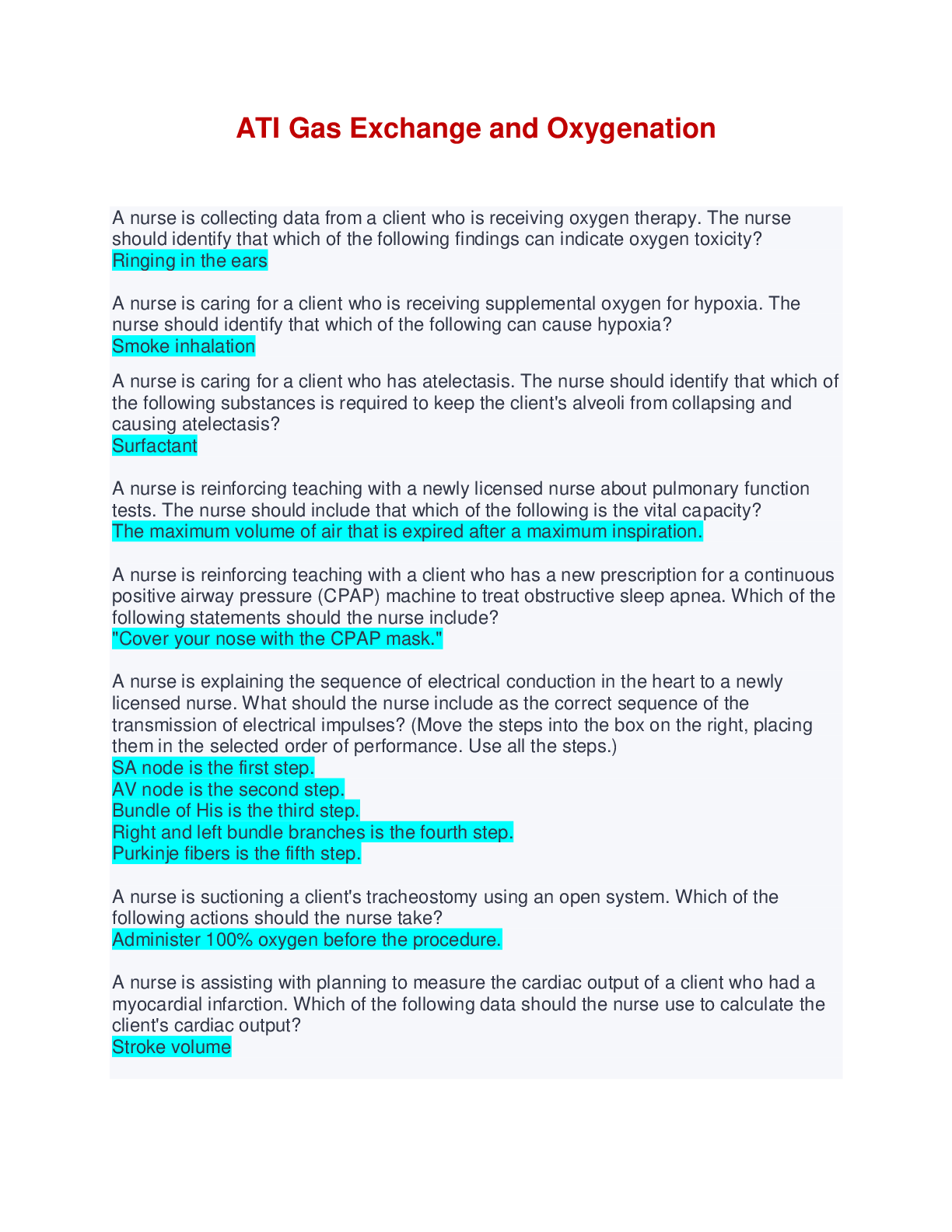






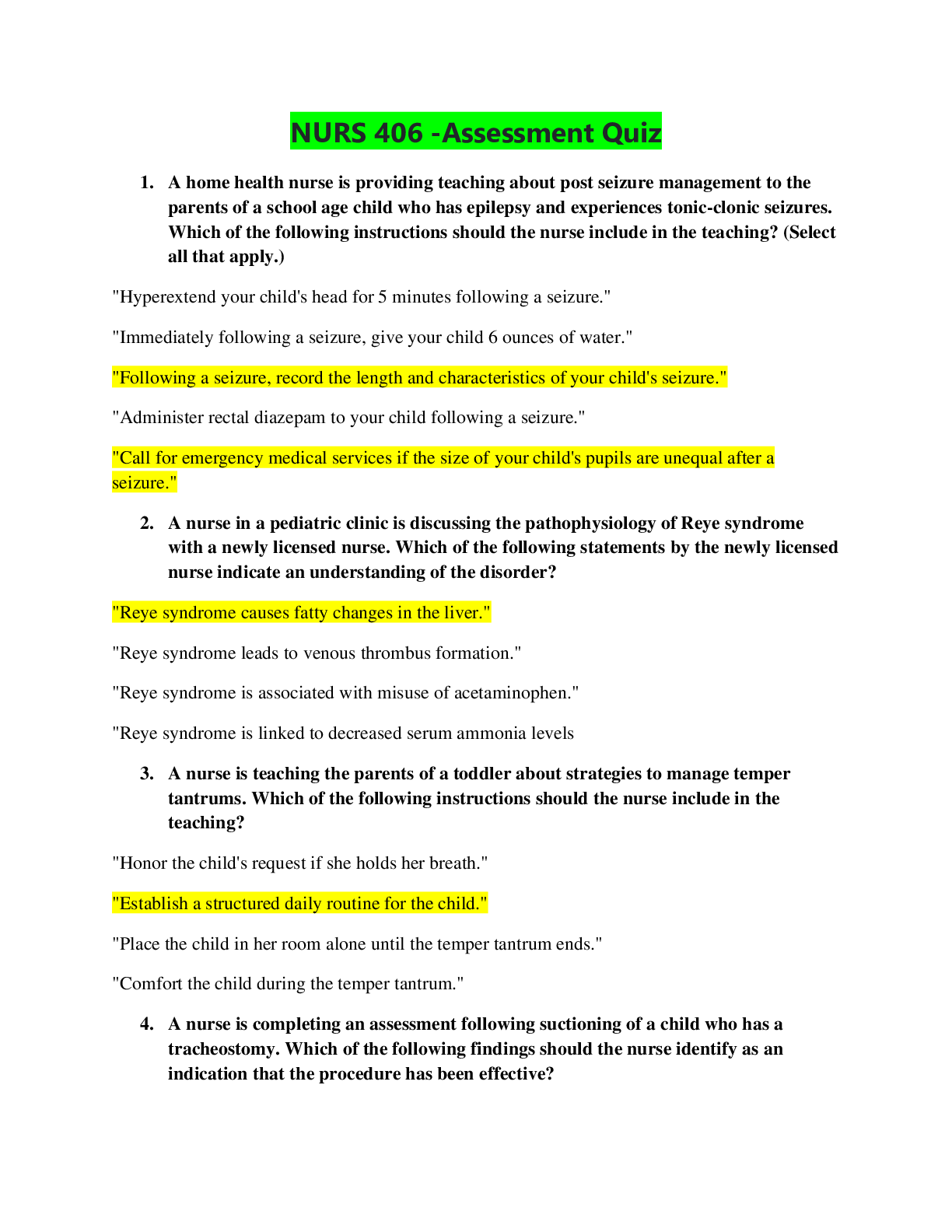





.png)
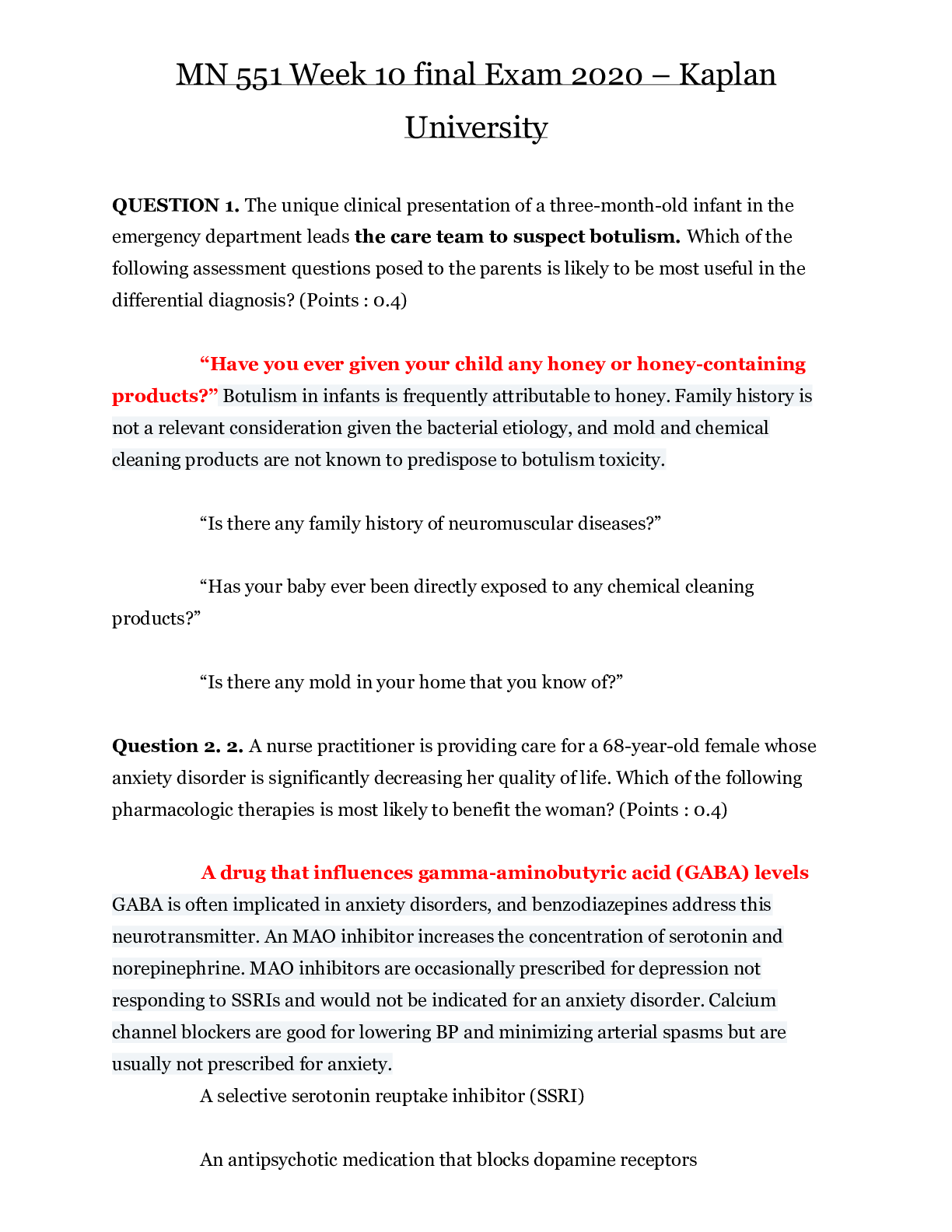

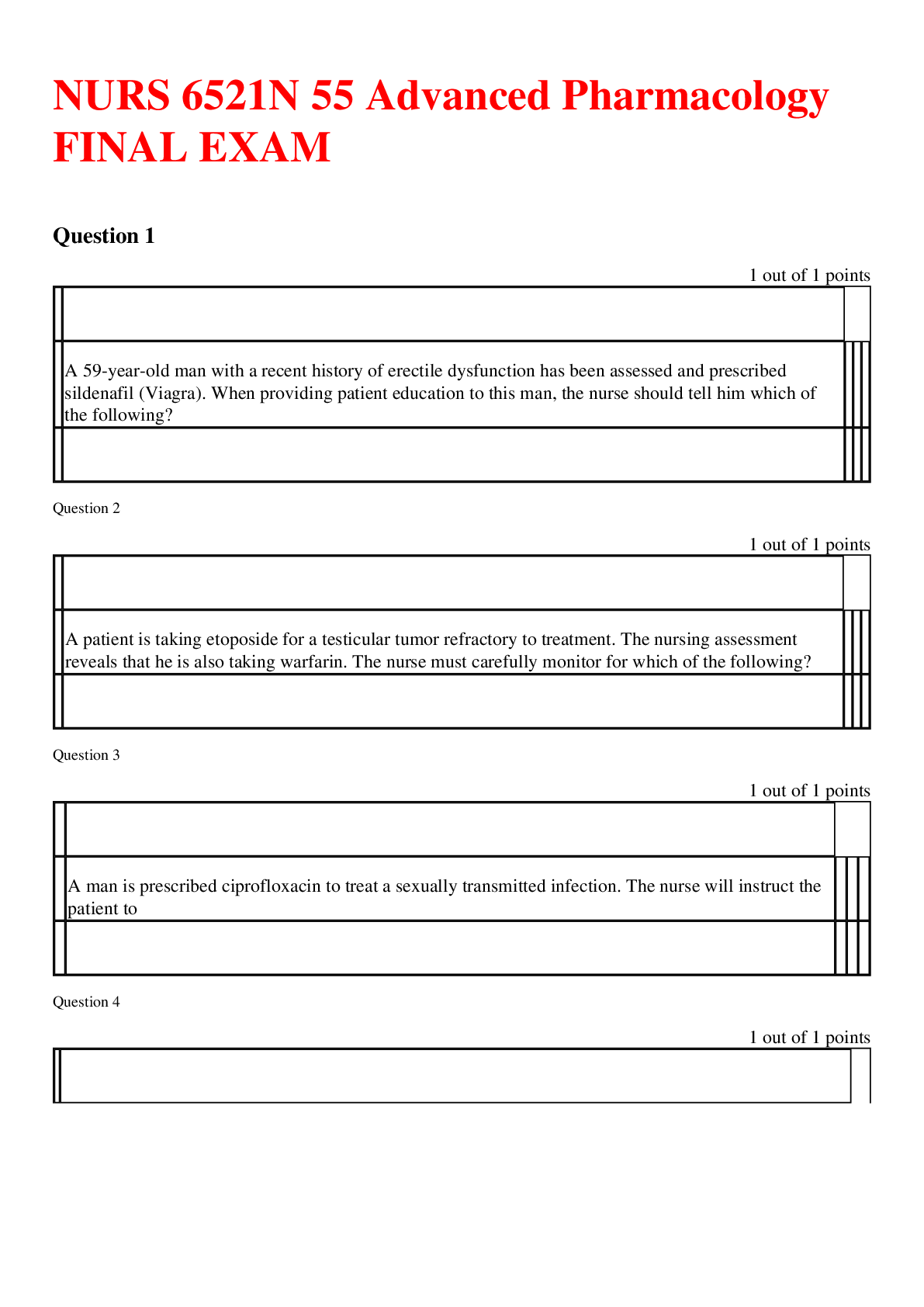
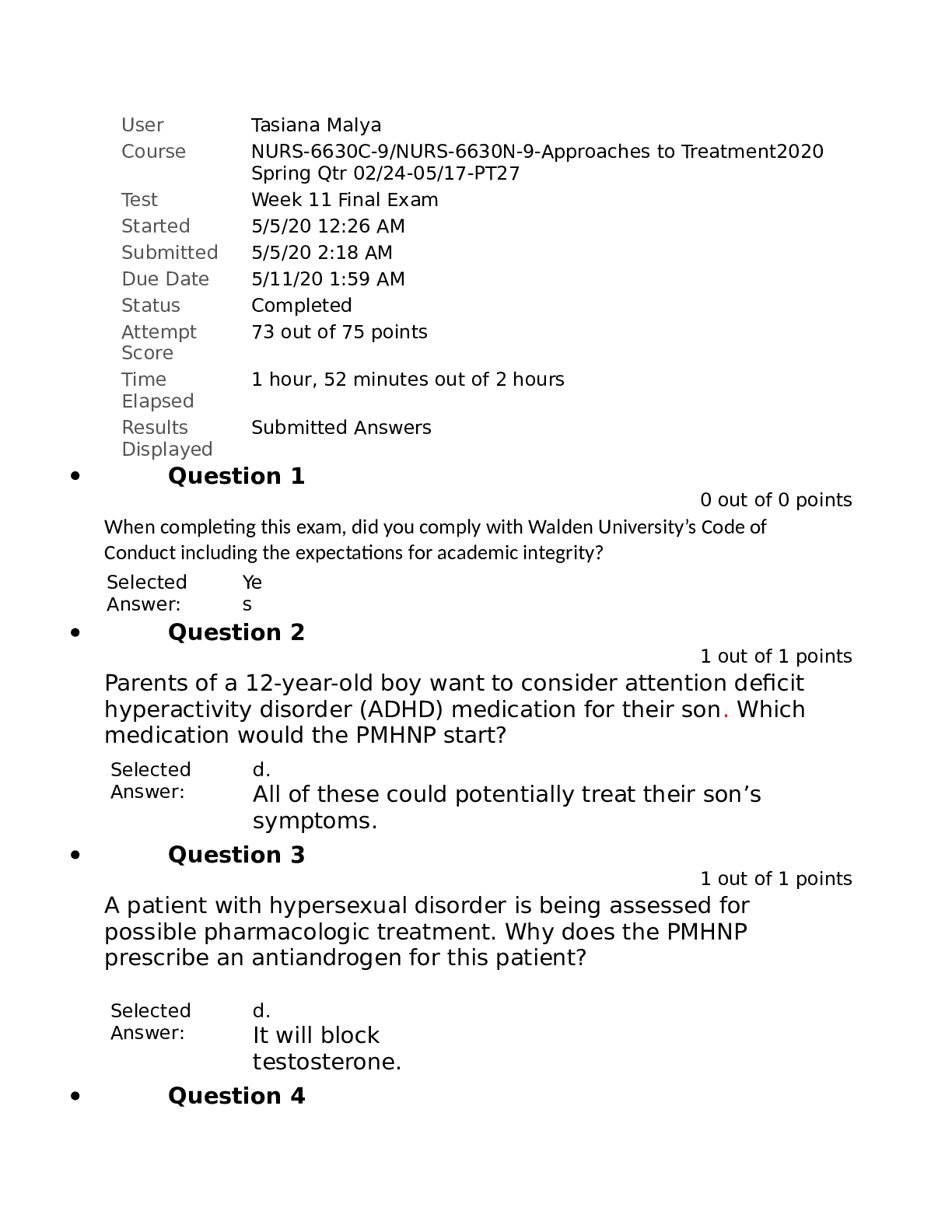

 – Strayer University.png)
 – Strayer University.png)
